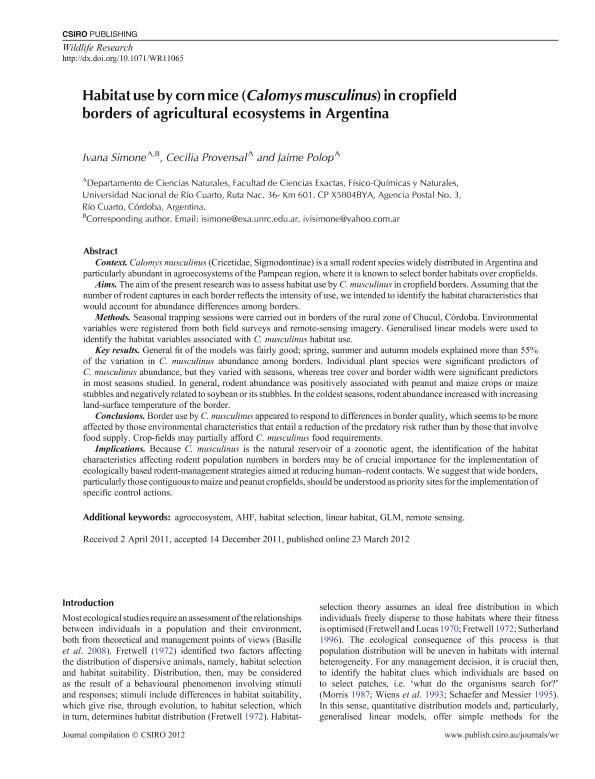Mostrar el registro sencillo del ítem
dc.contributor.author
Simone, Ivana

dc.contributor.author
Provensal, María Cecilia

dc.contributor.author
Polop, Jaime Jose

dc.date.available
2023-04-21T16:37:04Z
dc.date.issued
2012-03
dc.identifier.citation
Simone, Ivana; Provensal, María Cecilia; Polop, Jaime Jose; Habitat use by corn mice (Calomys musculinus) in cropfield borders of agricultural ecosystems in Argentina; Csiro Publishing; Wildlife Research; 39; 2; 3-2012; 112-122
dc.identifier.issn
1035-3712
dc.identifier.uri
http://hdl.handle.net/11336/194955
dc.description.abstract
Context Calomys musculinus (Cricetidae, Sigmodontinae) is a small rodent species widely distributed in Argentina and particularly abundant in agroecosystems of the Pampean region, where it is known to select border habitats over cropfields. Aims The aim of the present research was to assess habitat use by C. musculinus in cropfield borders. Assuming that the number of rodent captures in each border reflects the intensity of use, we intended to identify the habitat characteristics that would account for abundance differences among borders. Methods Seasonal trapping sessions were carried out in borders of the rural zone of Chucul, Crdoba. Environmental variables were registered from both field surveys and remote-sensing imagery. Generalised linear models were used to identify the habitat variables associated with C. musculinus habitat use. Key results General fit of the models was fairly good; spring, summer and autumn models explained more than 55% of the variation in C. musculinus abundance among borders. Individual plant species were significant predictors of C. musculinus abundance, but they varied with seasons, whereas tree cover and border width were significant predictors in most seasons studied. In general, rodent abundance was positively associated with peanut and maize crops or maize stubbles and negatively related to soybean or its stubbles. In the coldest seasons, rodent abundance increased with increasing land-surface temperature of the border. Conclusions Border use by C. musculinus appeared to respond to differences in border quality, which seems to be more affected by those environmental characteristics that entail a reduction of the predatory risk rather than by those that involve food supply. Crop-fields may partially afford C. musculinus food requirements. Implications Because C. musculinus is the natural reservoir of a zoonotic agent, the identification of the habitat characteristics affecting rodent population numbers in borders may be of crucial importance for the implementation of ecologically based rodent-management strategies aimed at reducing humanrodent contacts. We suggest that wide borders, particularly those contiguous to maize and peanut cropfields, should be understood as priority sites for the implementation of specific control actions.
dc.format
application/pdf
dc.language.iso
eng
dc.publisher
Csiro Publishing

dc.rights
info:eu-repo/semantics/openAccess
dc.rights.uri
https://creativecommons.org/licenses/by-nc-sa/2.5/ar/
dc.subject
AGROECOSYSTEM
dc.subject
AHF
dc.subject
GLM
dc.subject
HABITAT SELECTION
dc.subject
LINEAR HABITAT
dc.subject
REMOTE SENSING.
dc.subject.classification
Ecología

dc.subject.classification
Ciencias Biológicas

dc.subject.classification
CIENCIAS NATURALES Y EXACTAS

dc.title
Habitat use by corn mice (Calomys musculinus) in cropfield borders of agricultural ecosystems in Argentina
dc.type
info:eu-repo/semantics/article
dc.type
info:ar-repo/semantics/artículo
dc.type
info:eu-repo/semantics/publishedVersion
dc.date.updated
2023-04-20T16:10:07Z
dc.identifier.eissn
1448-5494
dc.journal.volume
39
dc.journal.number
2
dc.journal.pagination
112-122
dc.journal.pais
Australia

dc.journal.ciudad
Collingwood
dc.description.fil
Fil: Simone, Ivana. Universidad Nacional de Río Cuarto. Facultad de Ciencias Exactas, Fisicoquímicas y Naturales. Departamento de Ciencias Naturales; Argentina. Consejo Nacional de Investigaciones Científicas y Técnicas; Argentina
dc.description.fil
Fil: Provensal, María Cecilia. Universidad Nacional de Río Cuarto. Facultad de Ciencias Exactas, Fisicoquímicas y Naturales. Departamento de Ciencias Naturales; Argentina
dc.description.fil
Fil: Polop, Jaime Jose. Universidad Nacional de Río Cuarto. Facultad de Ciencias Exactas, Fisicoquímicas y Naturales. Departamento de Ciencias Naturales; Argentina
dc.journal.title
Wildlife Research

dc.relation.alternativeid
info:eu-repo/semantics/altIdentifier/doi/http://dx.doi.org/10.1071/WR11065
dc.relation.alternativeid
info:eu-repo/semantics/altIdentifier/url/https://www.publish.csiro.au/wr/WR11065
Archivos asociados
